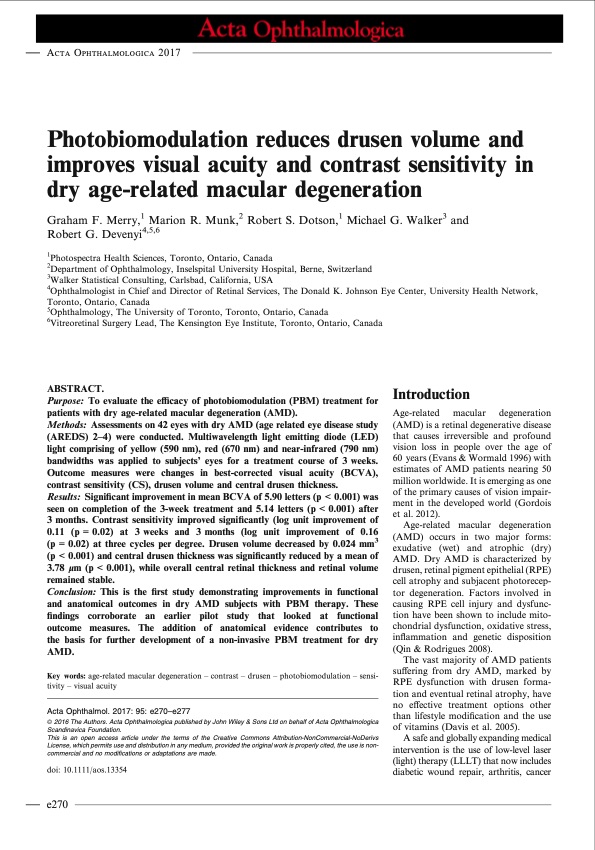
PDF Publication Title:
Text from PDF Page: 001
Acta Ophthalmologica 2017 Photobiomodulation reduces drusen volume and improves visual acuity and contrast sensitivity in dry age-related macular degeneration Graham F. Merry,1 Marion R. Munk,2 Robert S. Dotson,1 Michael G. Walker3 and Robert G. Devenyi4,5,6 1Photospectra Health Sciences, Toronto, Ontario, Canada 2Department of Ophthalmology, Inselspital University Hospital, Berne, Switzerland 3Walker Statistical Consulting, Carlsbad, California, USA 4Ophthalmologist in Chief and Director of Retinal Services, The Donald K. Johnson Eye Center, University Health Network, Toronto, Ontario, Canada 5Ophthalmology, The University of Toronto, Toronto, Ontario, Canada 6Vitreoretinal Surgery Lead, The Kensington Eye Institute, Toronto, Ontario, Canada ABSTRACT. Purpose: To evaluate the efficacy of photobiomodulation (PBM) treatment for patients with dry age-related macular degeneration (AMD). Methods: Assessments on 42 eyes with dry AMD (age related eye disease study (AREDS) 2–4) were conducted. Multiwavelength light emitting diode (LED) light comprising of yellow (590 nm), red (670 nm) and near-infrared (790 nm) bandwidths was applied to subjects’ eyes for a treatment course of 3 weeks. Outcome measures were changes in best-corrected visual acuity (BCVA), contrast sensitivity (CS), drusen volume and central drusen thickness. Results: Significant improvement in mean BCVA of 5.90 letters (p < 0.001) was seen on completion of the 3-week treatment and 5.14 letters (p < 0.001) after 3 months. Contrast sensitivity improved significantly (log unit improvement of 0.11 (p = 0.02) at 3 weeks and 3 months (log unit improvement of 0.16 (p = 0.02) at three cycles per degree. Drusen volume decreased by 0.024 mm3 (p < 0.001) and central drusen thickness was significantly reduced by a mean of 3.78 lm (p < 0.001), while overall central retinal thickness and retinal volume remained stable. Conclusion: This is the first study demonstrating improvements in functional and anatomical outcomes in dry AMD subjects with PBM therapy. These findings corroborate an earlier pilot study that looked at functional outcome measures. The addition of anatomical evidence contributes to the basis for further development of a non-invasive PBM treatment for dry AMD. Key words: age-related macular degeneration – contrast – drusen – photobiomodulation – sensi- tivity – visual acuity Acta Ophthalmol. 2017: 95: e270–e277 a 2016 The Authors. Acta Ophthalmologica published by John Wiley & Sons Ltd on behalf of Acta Ophthalmologica Scandinavica Foundation. This is an open access article under the terms of the Creative Commons Attribution-NonCommercial-NoDerivs License, which permits use and distribution in any medium, provided the original work is properly cited, the use is non- commercial and no modifications or adaptations are made. doi: 10.1111/aos.13354 Introduction Age-related macular degeneration (AMD) is a retinal degenerative disease that causes irreversible and profound vision loss in people over the age of 60 years (Evans & Wormald 1996) with estimates of AMD patients nearing 50 million worldwide. It is emerging as one of the primary causes of vision impair- ment in the developed world (Gordois et al. 2012). Age-related macular degeneration (AMD) occurs in two major forms: exudative (wet) and atrophic (dry) AMD. Dry AMD is characterized by drusen, retinal pigment epithelial (RPE) cell atrophy and subjacent photorecep- tor degeneration. Factors involved in causing RPE cell injury and dysfunc- tion have been shown to include mito- chondrial dysfunction, oxidative stress, inflammation and genetic disposition (Qin & Rodrigues 2008). The vast majority of AMD patients suffering from dry AMD, marked by RPE dysfunction with drusen forma- tion and eventual retinal atrophy, have no effective treatment options other than lifestyle modification and the use of vitamins (Davis et al. 2005). A safe and globally expanding medical intervention is the use of low-level laser (light) therapy (LLLT) that now includes diabetic wound repair, arthritis, cancer e270PDF Image | Photobiomodulation reduces drusen in macular degeneration

PDF Search Title:
Photobiomodulation reduces drusen in macular degenerationOriginal File Name Searched:
aos-13354.pdfDIY PDF Search: Google It | Yahoo | Bing
Cruise Ship Reviews | Luxury Resort | Jet | Yacht | and Travel Tech More Info
Cruising Review Topics and Articles More Info
Software based on Filemaker for the travel industry More Info
The Burgenstock Resort: Reviews on CruisingReview website... More Info
Resort Reviews: World Class resorts... More Info
The Riffelalp Resort: Reviews on CruisingReview website... More Info
| CONTACT TEL: 608-238-6001 Email: greg@cruisingreview.com | RSS | AMP |